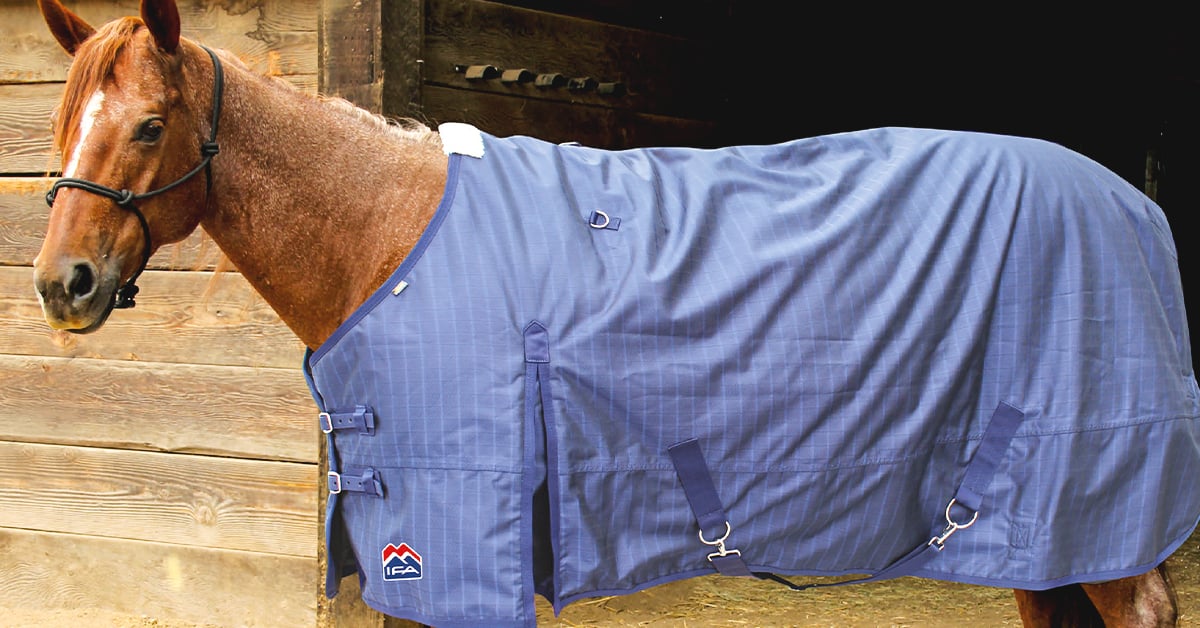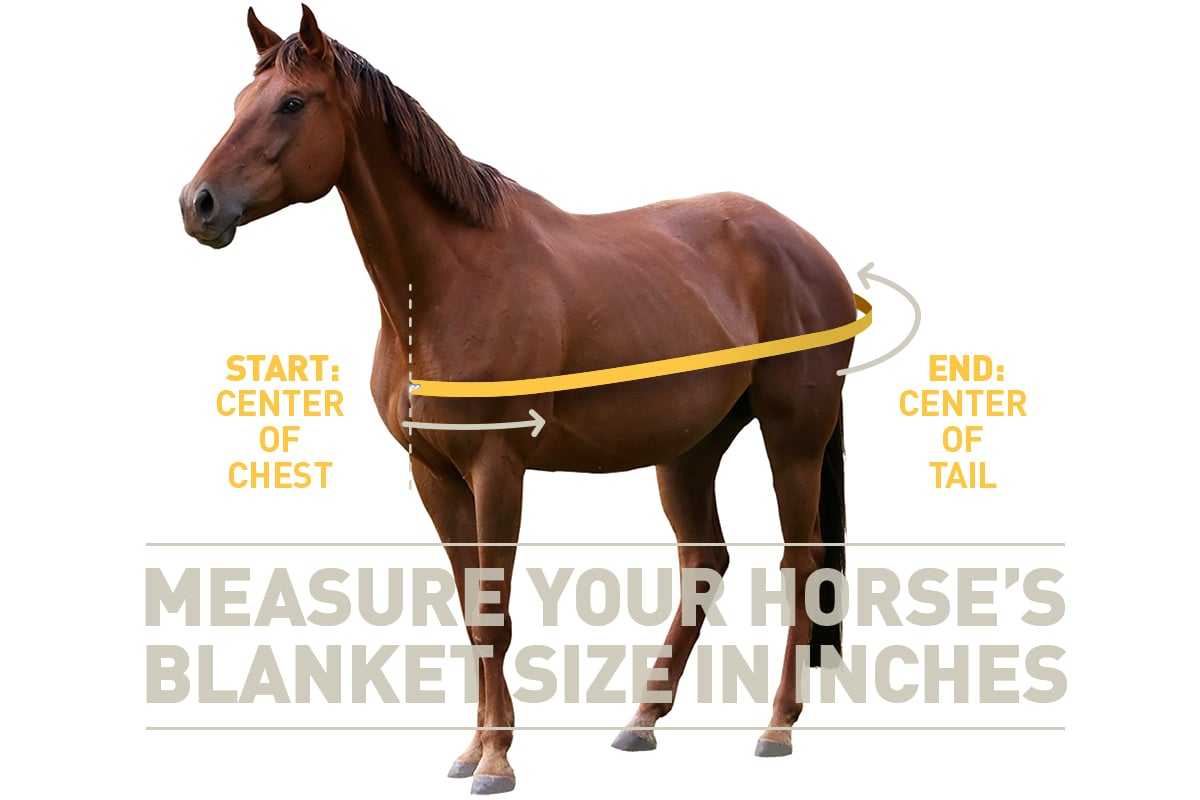
It’s not unusual to see more people coming in to buy horse blankets when the temperatures start to drop each fall—especially in years like this one when we seemingly go from fall to winter overnight.
Some people are coming in to replace old blankets. Others are coming in to buy a blanket that’s a little heavier or a little lighter than the ones they currently have. And yet, others are coming in to buy a blanket for the first time for a variety of reasons.
Regardless, we get a lot of questions about horse blankets when the temperatures start to drop, so we’ll address some of the most common questions here…
Does my horse need a blanket this winter, and if so, what kind?
This may seem like the most obvious statement in the world, but whether or not your horse needs a blanket depends entirely on your horse and your situation.
- What breed is your horse?
- Does it typically put on a healthy winter coat?
- Is it clipped?
- Is it eating enough feed?
- Does it have access to shelter?
- Is it healthy or does it have a compromised health condition?
- Is it wintering high in the mountains or in a more temperate valley?
One way to think about it is this: Blanketing your horse is a commitment at the start of the season. Your horse will grow a hair coat that reflects your blanketing, and it’s important that you do not over-blanket.
A good rule to live by is that is always better to under-blanket because your horse can warm up much faster than they can cool off. If your horse sweats due to over-blanketing, they can become chilled and sick.
If your blanket is waterproof, make sure it’s also breathable, so the heat your horse puts off can evaporate through the blanket—keeping your horse dry.
Keep in mind, using a blanket to keep your horse warm, dry, and comfortable is not the only benefit of using a blanket in the winter months. Using a blanket will also reduce winter hair growth, which means less grooming from shedding come spring. It also means keeping that cleaner “slicker” look all winter. Blanketing also keeps your horse clean from the mud and muck of the winter months, which makes prepping them to ride much easier.

What are the different types of winter blankets to consider?
There are two basic types—Turnout Blankets and Stable Blankets—and they both have different purposes.
Turnout blankets
Turnout blankets are weather/waterproof blankets. Regardless of winter weather conditions, your horse can be out in the elements with a turnout blanket and stay comfortable.
When buying a turnout blanket, you’ll want to be mindful of both the blanket’s denier and fill. The denier is the blanket’s outer shell material and comes in degrees of toughness. For example a 1200 denier is going to hold up better from snags on something (wire, fencing, tree branches etc.) compared to a 600 denier. And it’s the same with the weight of the blanket’s fill—the higher the gram number, the warmer and heavier the blanket will be. For example, a 300 gram fill will be warmer than a 200 gram fill.
Stable blankets
Stable blankets on the other hand are windproof and will keep your horse comfortable when temperatures drop, but they’re not meant for wet, rainy, snowy conditions. Rather, they’re meant to be used inside—in barns and stable environments as the name suggests.
How important is the blanket’s fit?
Fit is extremely important. Your horse blanket should fit snug but not tight.
Blankets that are too tight will abrade your horse in a number of places, which will inevitably lead to sores on the shoulders, chest, and withers.
Blankets that are too loosely-fitted can lead to serious injury if your horse gets a leg caught up in the straps, or if the blanket shifts and hangs off your horse – opening up the possibility of the blanket snagging on any number of things.

How do you measure for a blanket?
Measuring your horse is pretty easy and straightforward and is determined by measuring the distance (in inches) from your horse’s chest (the breast below the neck) to their tail.
You’ll need a cloth measuring tape (also called a seamstress tape) and, ideally, a friend to stand in front of your horse to hold one end of the tape in place. Make sure your horse is standing on level ground, and that they stand straight, facing forward.
Place one end of the tape at the center of the chest. Bring the tape around the widest part of the shoulder, slightly upwards across the ribs and flank, around the widest part of the hindquarter, and to the center of tail. Whatever the length is from the chest to the tail is blanket size for your horse.
The most common blanket sizes are 75" and 78", and a general rule of thumb is that if your horse’s measurement doesn’t correspond to an exact blanket size, go up to the next blanket size.
Additional considerations
When riding and working your horse through the cold winter months, be sure to properly cool your horse off before exposing them to the cold weather. Cool them off slowly by first walking the horse around with the saddle and pad in place.
After they’ve cooled down a bit and you’re ready to unsaddle, it’s a good idea to put a moisture-wicking cooling sheet on so they don’t get chilled by the cold air. If the sheet gets damp, replace it with a dry one. Once your horse is dry you can put on a stable blanket and turn them into their stall.
Make sure you increase your horse’s roughage intake at least 10% during the winter to help them stay warm, as cold weather causes them to burn more calories.
Don’t base your horse’s blanket needs on how cold or hot you may be. Horses are better equipped to adjust to temperatures than we are.
Lastly, remember that every horse is different, so when it comes to blankets, what one horse needs may be completely different from another.
If you have more questions about horse blankets, or need help deciding which type is best for your horse, visit your local IFA Country Store and we'll be happy to help you find exactly what your horse needs to stay healthy and warm over the winter months.
Information for this article was provided by Darla Barkdull, Branch Manager, Elko IFA Country Store; Jordan Ellis, Branch Manager, Las Vegas IFA Country Store; Lindsey Hutchison, Animal Health, Tack & Farrier Dept. Manager, Riverton IFA Country Store; Tina Chamberlain, Animal Health, Tack & Farrier Dept. Manager, Cedar City IFA Country Store; and Terry Boren, Tack, Farrier & Pet Category Manager, IFA.









